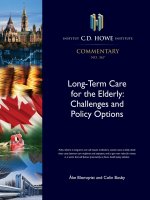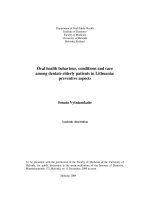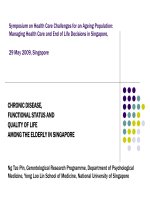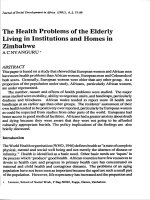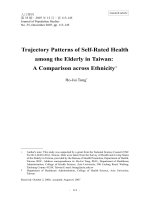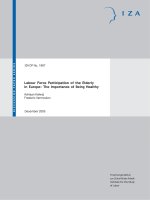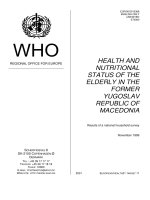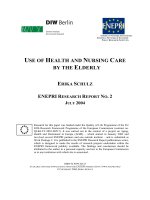Barriers to Health Care among the Elderly in Japan ppt
Bạn đang xem bản rút gọn của tài liệu. Xem và tải ngay bản đầy đủ của tài liệu tại đây (176.99 KB, 12 trang )
Int. J. Environ. Res. Public Health 2010, 7, 1330-1341; doi:10.3390/ijerph7041330
International Journal of
Environmental Research and
Public Health
ISSN 1660-4601
www.mdpi.com/journal/ijerph
Article
Barriers to Health Care among the Elderly in Japan
Chiyoe Murata
1,
*, Tetsuji Yamada
2
, Chia-Ching Chen
3
, Toshiyuki Ojima
1
, Hiroshi Hirai
4
and
Katsunori Kondo
4
1
Hamamatsu University School of Medicine, Department of Community Health and Preventive
Medicine, 1-20-1 Handayama, Higashiku, Hamamatsu, 431-3192, Japan;
E-Mail:
2
Rutgers University, Department of Economics and Center for Children and Childhood Studies,
Camden, NJ 08102, USA; E-Mail:
3
New York Medical College, School of Health Sciences & Practice, Department of Epidemiology &
Community Health, Valhalla, NY 10595, USA; E-Mail:
4
Nihon Fukushi University, Center for Well-being and Society, 5-22-35 Chiyoda Nakaku Nagoya,
Aichi, 460-0012, Japan; E-Mails: (H.H.); (K.K.)
* Author to whom correspondence should be addressed; E-Mail: ;
Tel.: +81-53-435-2333; Fax: +81-53-435-2341.
Received: 21 December 2009; in revised form: 9 March 2010 / Accepted: 15 March 2010 /
Published: 26 March 2010
Abstract: Japan is undergoing a set of health care reforms aimed at cutting rising health
care costs and increasing the efficiency of health care delivery. This empirical study used a
large-scale community survey on 15,302 elderly people 65 years and older (56.0% women)
conducted in seven municipalities in 2006, to reveal clear-cut evidence of barriers to
necessary care. The reasons for not getting health care is attributed to health care cost for
the elderly with lower income, while higher income counterparts reported being busy or
having a condition not serious enough to seek care.
Keywords: cost burden; socioeconomic status (SES); barriers to health care
OPEN ACCESS
Int. J. Environ. Res. Public Health 2010, 7
1331
1. Introduction
In addition to unhealthy behaviors, such as smoking, poor diet, or lack of exercise, recent evidence
suggests that socioeconomic status is a key underlying factor that influences health. Various studies
consistently found that low socioeconomic status is associated with ill health [1-4]. Socioeconomic
status assessed by income, education, or occupation is associated with various health problems, such as
depression [1,2], hypertension, and functional status [3]. Mortality rates are also higher among
individuals of low socioeconomic status [4]. To tackle such health disparities across different
socioeconomic strata, the World Health Organization (WHO) recently published a report entitled
“Closing the gap in a generation: health equity through action on the social determinants of health,
Final Report of the Commission on Social Determinants of Health” [5]. The report clearly states that
such inequalities in health arise out of the environment in which we live; grow up, work, and age. In
addition, countries at all levels of income, health and illness follow a social gradient: the lower the
socioeconomic position, the worse the health of the population is.
Although socioeconomic status is clearly associated to morbidity and mortality, structural links for
such associations are less comprehensible. One such link might be knowledge. For example, education
provides knowledge and life skills necessary to gain access to information and resources that promote
health. This is partly explained by the fact that unhealthy lifestyles are more prevalent among people of
low socioeconomic status [6]. Education also provides more opportunities for higher income that may
provide better living conditions, such as nutrition, housing, and schooling. Employment status is
another important factor in determining health. Unemployed individuals have worse health than their
employed counterparts. Less educated people are more likely to be unemployed. Higher
socioeconomic status brings us necessary resources to cope with ill health [4,5,7]. Although the
association between income and health is stronger in lower income brackets, such associations are
observed among richer populations as well. This is supported by a comparative study of 11 European
nations which observed health disparity across socioeconomic status groups even in relatively
egalitarian societies, such as Sweden or Norway [8]. Furthermore, redistributive policies play an
important role in reducing health disparity. A study by Navarro et al. analyzed data over a 50-year
period in OECD nations and found that redistributive policies have a salutary effect on infant mortality
or life expectancy at birth [9].
In addition to income, education, and occupation, access to health care is a vital determinant of
health regardless of the nation’s income level [5]. Yet, the access to care problem has not been fully
examined in richer nations. Among studies conducted in such nations, Shi and Stevens affirmed that
lower socioeconomic status individuals have poorer access to health care by using the national
representative sample in the US [10]. Access to care generally encompasses two dimensions. One is
physical access, such as the distance to health care facilities or transportation. Another is financial
access, such as cost of care or medication. Various studies demonstrated that when co-insurance
increased, those with lower income tended to stop going to doctors. Reimbursement under co-
insurance system is based on percent basis. This is different from a co-payment, which is a fixed cash
amount paid to the beneficiary per procedure or per day in the hospital [11]. Although such systems
may offer financial protection, how such a system is framed may influence population health. A study
in Japan demonstrated that when co-insurance increased from 20% to 30%, a significant decrease in
Int. J. Environ. Res. Public Health 2010, 7
1332
physician visits was observed among diabetic patients with no complications [12]. A comparative
study on three European nations (i.e., France, Germany, and Spain) detailed that an increase in patient
cost sharing reduced the frequency of physician visits, especially among people in lower social
classes [13]. Similar results are reported in other nations, such as South Korea or Taiwan [14,15].
These studies also underscored that while increases in patient cost sharing reduced visits to physicians,
hospital admissions increased especially among lower income people, suggesting that an increase in
out of pocket expenditures might have a negative effect on health through lost opportunities for
timely care.
Brief description of Japanese National Health Insurance System
Japan has maintained a nationwide social health insurance system built on the German social health
insurance model for more than 30 years. This system covers almost the entire population and is
financed by premiums paid by insured persons, employers, and government compensation. The
relatively low-cost, universal health insurance system is recognized as a major achievement. Japanese
citizens receive services from any physician or hospital, with no difference in cost, and physicians are,
in principle, free to treat or prescribe as they see fit. Under this system Japan’s low infant mortality
rate and high life expectancy at birth are among the best in the world [16]. However, pressures are
mounting for health care reform to restrain future medical costs in the face of an increasing aging
population. In Japan, the National Health Insurance System reimburses on a percentage basis, and the
patient pays co-insurance. As the system currently pays 70% of the medical charges, patients (except
for children and the elderly) pay the remaining 30%.
Recently, however, there is an issue which requires attention. As of April, 2008, a new health
insurance system was launched for the elderly 75 years and older. With the establishment of this
system, the government intended to separate the elderly who need more medical attention and use a
higher portion of health care resources compared to younger generations. The government intends to
restrain an increase in medical costs among the elderly. This system might pose barriers to necessary
care, especially among low income individuals.
In this paper, we discuss the associations between socioeconomic status and access to care by
investigating possible barriers to health care, examining the scope of health disparities across different
socioeconomic groups, and exploring factors which contribute to their associations among the elderly
in Japan.
2. Methods
2.1. Study Population
The present analysis is based on the Aichi Gerontological Evaluation Study (AGES) Project data.
The AGES Project is an on-going prospective cohort study that started in two municipalities in Aichi
Prefecture, Japan, in 1999. This project aims at investigating factors related to the loss of healthy
years, such as functional decline or cognitive impairment, among non-institutionalized elderly subjects
aged 65 years or older [17-19]. In 2003, the second wave of surveys was conducted on a random
sample of functionally independent, community-dwelling elderly subjects (i.e., who were not eligible
Int. J. Environ. Res. Public Health 2010, 7
1333
for public, long-term nursing care) in fifteen municipalities from three prefectures. During 2006 and
2007, the third wave of surveys was conducted in nine municipalities from three prefectures. For the
current study, we used data from the third wave, which contains data on access to health care.
Overall response rate of the third wave survey (mailed questionnaire with three versions) was
60.8% and 39,765 elderly subjects completed the questionnaire. Subjects of the current study were
15,302 elderly people (6,737 men and 8,565 women) living in six municipalities from three prefectures
who provided complete data on age and sex, and answered the access to health care version of the
survey. Mean age was 74.2 years (age range: 65–100). All respondents were literate and understood
the Japanese language well. As a general rule, proxy respondents were not permitted. The study
protocol and informed consent procedure were approved by the Ethics Committee in Research of
Human Subjects at Nihon Fukushi University.
2.2. Study Variables
The variable of interest is health care seeking behaviors. For health care seeking behaviors, we
asked if the elderly had a regular place to go when they were ill (regular source of health care), if they
had a regular dentist (regular source of dental care), if they underwent health check-ups in the past, and
if they ever postponed or stopped seeking health care in the past year (delayed care). We also asked the
reasons for not seeking care.
For health status, we used self-assessed health status, and diagnosed illnesses under treatment.
Self-assessed health was elicited by asking “What is your current health status: excellent, good, fair, or
poor?” with answers dichotomized into excellent/good or fair/poor. To evaluate functional status, the
survey asked whether they had difficulty or needed someone’s assistance in performing any of the
following ADLs (activities of daily living): walking, bathing, and toileting (0 = without difficulty,
1 = can perform the activity with someone’s partial help, 2 = can’t perform the activity without help of
others). Those scoring 0 were considered having no difficulty in performing any ADLs. Diagnosed
illnesses were ascertained by asking if they were currently receiving treatment for any of the
following: cancer, heart disease, stroke, hypertension, diabetes, obesity, hyperlipidemia, osteoporosis,
arthritis, trauma, respiratory illness, gastrointestinal illness, liver disease, mental illness, visual/hearing
impairment, dysphagia, urinary disease, sleep disorder, and others.
Health behaviors, such as smoking and drinking, were also assessed, since studies to date indicated
that low socioeconomic status is associated with unhealthy lifestyles [6]. As the socioeconomic status
measure we used annual equivalized income computed by the square root of the number of people in
the household [20]. The purpose of such computation was to adjust the income for family size. Income
was defined as pre-tax annual household income, including regular salary, pensions, social security,
and any form of temporary earnings during the last year. For the analysis, equivalized income in
Japanese yen (¥) was divided into tertiles (low: < ¥1.6 million, middle: ¥1.6 million ≤ ¥ < ¥2.5 million,
and high: ¥2.5 million ≤). As of December 2009, one US dollar ($) was the equivalent of ¥87.20
Japanese yen.
